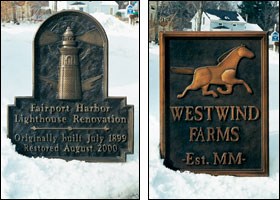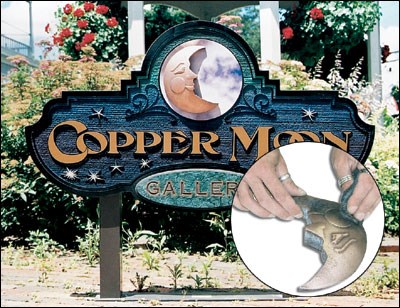Signing On a New Finish
Blending new technology with old time craftsmanship gave Northcoast Sign Works its niche in the sign creating business…
About 15 years ago, there was a revolution in the sign industry. Computers entered the arena. Gone were the days of hand-painted signs prepared in the backyard garage of Joe the Sign Guy. Many franchises were able to offer quick turnaround signage using computer technology to design and cleanly cut pressure-sensitive vinyls in an array of colors. "Although it took away business from many of the old-time sign makers," stated Jim Hamilton, president of Northcoast Signworks, "It gave the business a more professional image."
Even so, Jim felt that there was something missing in the "new" industry. Sure, technology was great, but the look of the old-fashioned woodworking and traditional craftsmanship were gone. "I saw a niche where we could use the best of today's technology and combine that with good old-fashioned woodworking," stated Mr. Hamilton.
Featured Content
Eight years ago Jim and his brother, Bill, joined forces to start Northcoast Signworks, which is presently located in an old firehouse and adjoining lumber mill in Richfield, OH. Jim had the background in marketing, while brother Bill had a degree in fine arts. Together, they built a unique business, specializing in high-end dimensional signage using high-tech production equipment and timeless finishing techniques, such as gold leaf, smaltz and a newer metal spray finish called LuminOre.
"One thing that has always kept us on the cutting edge," noted Mr. Hamilton, "is that we have always invested in technology. When CNC routers came into the field, we were one of the first to invest in one to reduce the labor involved in cutting the signs out of the substrates. We also invested in 3-D software so we could program the router to cut out intricate figures, such as firemen and lighthouses. It saves a lot of time."
Northcoast works mostly with high-density urethane substrates, since urethane is durable and light. However, one project with the Cleveland Zoo required a metal finish. Rather than work with metal to create the signs, Northcoast designed signs out of the urethane and gave them a metal finish using the LuminOre product. The product is 80% metal, which can be aluminum, brass, bronze, copper, iron, nickel-silver, stainless steel or an alloy. This is mixed with 20% binder and a small amount of catalyst. The mixture is sprayed cold using traditional HVLP technology. Bill usually applies the metal to approximately 0.008-0.01 mil. Parts are allowed to dry overnight; however, drying can be enhanced with heated lamps.
Although it is not paint, the finish does have a milk chocolate, paint-like appearance when it is finished. To bring out the luster and shine, the parts can be hand finished in a number of ways. The Cleveland Zoo wanted its signs to have a weathered Victorian look, since they were going to be part of an exhibit that transported people to the "Australian Outback." To achieve the look, Bill would spray many of the signs with a patina finish after coating them with LuminOre and then hand buff them, bringing out the weathered look. The best part was that the signs could be used outdoors without risk of cracking, chipping or peeling. The finish passes the ASTM D2565 weatherometer test, completing 3,000 hr without any delamination, corrosion, blisters or breakdown. In the Environtest machine for ASTM D2246, it completed 3,000 hr without delaminating, corroding, blistering or breaking down as well. The pull off strength was measured with a 1-2,000 psi scale using ASTM D4541-95 with no coating to substrate failures.
"When we first decided to try the product, we thought we would spray it and then be finished with it," stated Jim Hamilton. "But it is a metal. It must be finished to achieve the look you want. Even when you cast a sign at a foundry, you have to polish it and clean it before it is ready for hanging.
Northcoast does not have production-buffing equipment. It just would not make sense. There are so many different sizes and shapes of parts produced in the shop, that a standard setup would not be effective. Instead, everything is done by hand using steel wool (with or without buffing compounds) and blasting with abrasive grit or silica.
"Our best success with the LuminOre product has been by combining it with our 3-D software. It has allowed us to make large signs look metal that could not normally be created from metal because of the weight, casting costs, transportation costs, etc."
Northcoast makes a number of subdivision and other type of entryway signage. These pieces can be quite large; however, because they are made from urethane or even CorianTM, two people can install them. The Corian gives architects and designers an alternative to traditional substrates. They can create signs that look like sandstone, granite and marble. Combined with traditional paints and the LuminOre finish, the possibilities are seemingly endless.
For Northcoast, creating contrast is an essential part of the work. The metal spray process gives Bill the ability to create a variety of contrasts and looks. One particular project involved a resurrected exhibit of a Dunk Fish for the Cleveland Metroparks. "About 20 years ago, a thought-to-be-extinct fish was found in the Rocky River near Cleveland," Jim Hamilton reminisced. "About 10 years ago they made a fiberglass Dunk Fish for an exhibit and then stored it in the exhibit graveyard. Well, they decided to resurrect the Dunk Fish for an outdoor exhibit. Because the exhibit had to be strong and withstand the elements, we suggested the metal spray finish."
"We played a lot with the alloy finishes to get the right colors," noted Bill Hamilton. "The artists from the Cleveland Metroparks came out and worked on it with us. We ended up using copper, bronze and steel and buffed the colors together."
The applications for the spray metal finish are not limited to signage. It is being used in the furniture hardware, plumbing, architectural and other industries. It is popular because it can be used on an array of substrates, including foam, plastic, gypsum, wood, glass, granite, metal, fiberglass, plaster, ceramics, concrete, terra cotta, cardboard and paper.
For Northcoast Sign Works, the metal spray process has allowed the company to combine old world tradition and new age technology. So, actually the company is not just making signs, it is creating quality lasting impressions.





















